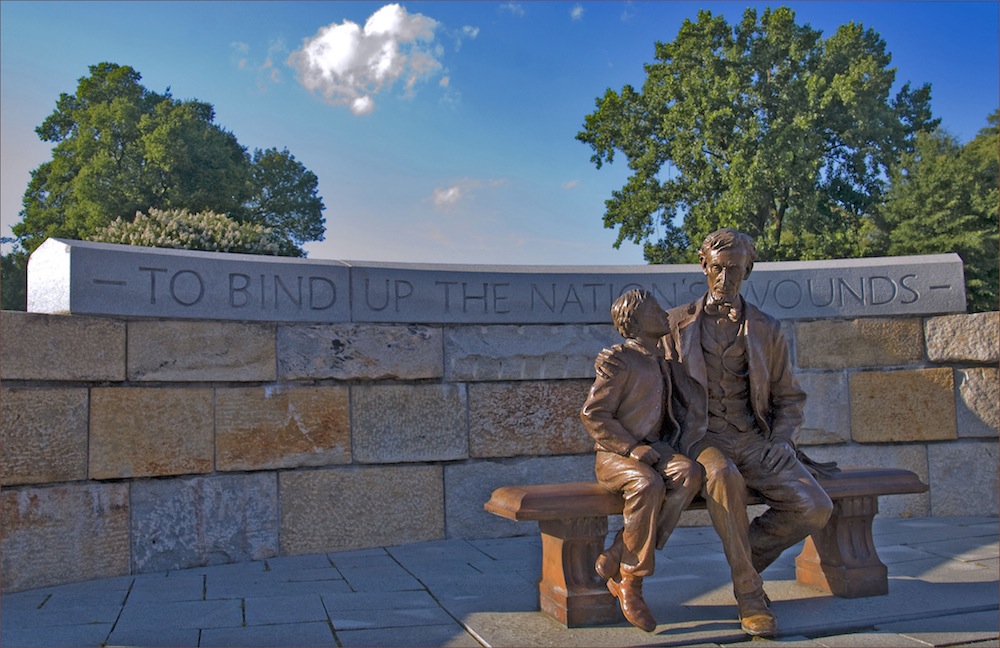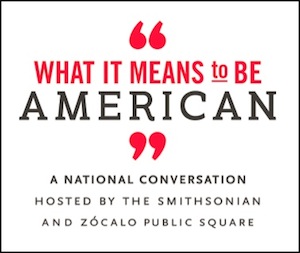
April 4, 1865. The conqueror entered Richmond, Virginia, on a rowboat with his son Tad, after nearing the fallen city by military steamer. President Abraham Lincoln was escorted and guarded by Union Army officers, but the victory scene was far from triumphal. He slipped in unannounced, to bear witness, not to preside over the vanquished.
Lincoln simply strode up the hills of Richmond, the enemy capital, passing the pearly state capitol building designed by Thomas Jefferson. He sauntered into the antebellum mansion on East Clay Street that had served as the “White House of the Confederacy,” headquarters to his nemesis, Jefferson Davis.
The Civil War was all but over, but Lincoln had only 10 more days to live, as he would be among the conflict’s final casualties.
That early spring day was the grandest day of Lincoln’s presidency, as measured by the Declaration’s pursuit of happiness. (We know he was fond of quoting Jefferson’s document.) It’s easy to forget he barely glimpsed the fruits of winning the war that took a toll of 620,000 lives and tore the nation asunder. The Civil War president had overseen it all. From the initial secession crisis to the North’s massive mobilization; from the initial hesitation of his generals in Virginia and the derring-do of his generals in the West to the crescendo of scorched-earth warfare; from delicate talk about war not being about slavery to emancipation; and now, from incessant war to thoughts of reconstruction and reconciliation, Lincoln was a president for all seasons.
As cruel events played out, here was Lincoln’s one chance to actually see and savor his success as commander-in-chief. Richmond was full of burnt wreckages, buildings smoldering from fires set by the evacuating Confederate army. There was not a battle, but a grim message from General Robert E. Lee that it was all over; the city could not be defended. He gave stern instructions to headstrong Jefferson Davis, president of the rebel states, to leave town. Richmond, though it was only 114 miles from Washington, felt more like the Deep South. The city overlooks the James River, where the slave trade had prospered.
The man who freed 4 four million of them was stepping foot right into the inner sanctum of slavery. How sweet the justice.
As a Lincoln scholar, I consider his visit to Richmond worthy as a story for the ages, one to pass on to our children. But I never heard a word about it in Civil War sesquicentennial events. The scene was missing in the movie Lincoln directed by Steven Spielberg, which was filmed in Richmond. So I felt compelled to take the trip, a two-hour train ride from my home in Washington.
With his top hat, 6-foot-4-inch stature, and curious countenance, there was no mistaking the president in person. Word flew around the town to produce an overjoyed reception by Richmond’s black community. Out on the streets, a throng of formerly enslaved men, women, and children sang, danced, and wept in exclaiming hosannas, glory to God, and thanksgiving to the man they called their Moses. It was even the season of Passover, the celebration of the Israelites’ escape from slavery to freedom. Some got down on their knees to thank “Father Abraham.” The man who set a people free had never seen such a profusion of gratitude. In fact, it remains an utterly singular scene in the annals of American history. Overcome, Lincoln mustered a few words for the multitude. He urged them to get up on their feet. And then he said, as Richmond lore has it: “Enjoy your liberty.”
The white people of Richmond naturally did the opposite, giving Lincoln sullen glares—“stony silence,” as a sign at the city’s American Civil War Center says. His security detail must have been relieved that the vanquished chose to express their feelings by merely locking their doors shut behind them and pulling their curtains.
For all the nights at the telegraph office he spent angsting over each update from the various fronts, the casualty counts he endured, all the generals he fired, he finally got to witness what it was all for. It wasn’t until three winters after signing the Emancipation Proclamation that he got to see the sun of emancipation with his own eyes, in exquisite black and white. He at last found a little sweetness, after so much salt. Lincoln wept more than once on the job.
As Harold Holzer, a leading Lincoln author, observes, the moving Richmond visit was also fraught with peril:
Never in world history had a conqueror entered a vanquished city so humbly and so openly. It really is one of the most extraordinary moments in the American experience. A man who had conducted the biggest and bloodiest and bitterest war ever fought up to that time exposing himself to his enemies, oblivious to the danger, surprised by the emotional greeting.
For Lincoln, the shambles of the Confederate capital were the stage to voice his vision for the future. Peace was coming to the land. The squall of cannonballs had passed. According to the American Civil War Center’s sign, “Let ’em up easy,” was how the author of the Gettysburg Address put his strategy going forward on that day.
On East Clay Street, the president’s destination was the Southern White House, which Davis had abandoned two days before. Lincoln asked for a glass of water and then held a meeting with his military officers in the parlor. He also spent time sitting in the library. The act of occupying this White House, if only for a few hours, carried devastating significance for Confederates out in the field still in denial that their cause’s fate was all but sealed.
And yet, when looking back on the Civil War, we don’t sufficiently appreciate the drama and importance of Lincoln’s day in Richmond, overshadowed as it is in memory by the encounter five days later between Lee and Grant at Appomattox Court House and Lincoln’s assassination at Ford’s Theater five days after that.
Truth be told, the genteel Virginia capital still feels like it’s waking up from a nightmare and is stuck recounting stories about when “Richmond fell.” The town’s main narrative lines Monument Avenue: statues of Lee and Stonewall Jackson, even J. E. B. Stuart, the “eyes and ears” who let Lee down at the fateful showdown at Gettysburg.
But back down by the riverside, there is a bronze statue of Lincoln and Tad. On National Park Service land, you can see the only statue of the 16th president in the former Confederacy, a relatively recent installation. “During his long walk into Richmond, Lincoln received a boisterous and prolonged welcome from the large population of African Americans,” the sign says. “Lincoln’s visit produced, in the words of a prominent modern historian, ‘the most unforgettable scenes of this unforgettable war.’”
This sign is a serious undersell. The word “boisterous” misses the majesty of this incredible turnaround in the fate of African-Americans in the heart of the Confederacy. No mention of slavery, no name with the quote. Clearly, the sign is trying to avoid giving offense in enemy terrain. The museum is, in fact, sited on the old Tredegar Iron Works, a major munitions maker for the Confederacy.
But it is a fine statue capturing the president’s pathos and the humanity of that landing in Richmond, especially knowing his days are numbered. The president is sitting without his hat, with his arm around his son. In his private life, Lincoln had a lenient philosophy of parenting—roughhousing with his younger sons on the floor of his office, letting them keep a goat for fun. The statue reminds us how Lincoln became, in four years, also a father figure to the nation, and would remain so, for generations to come.





Send A Letter To the Editors